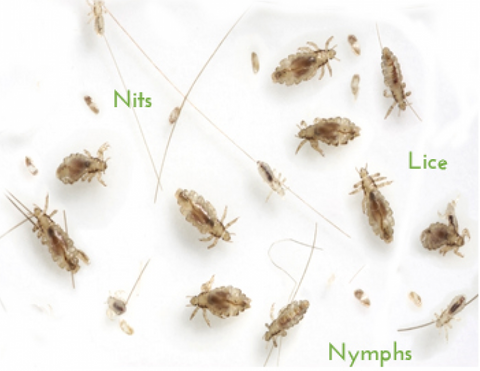Lice Facts

WHAT ARE LICE?
The head louse (plural lice) is scientifically known as Pediculus humanus capitis. Head lice are parasites. They need the warmth of the head and human blood to survive. Head lice have no wings, so they cannot fly. They have six legs with claws at the ends to attach themselves to hair. Head lice infestations can happen to anyone, but especially school-age children. Poor hygiene is not the cause of head lice!
NITS
| Nits are the eggs of head lice. The female louse secretes a glue-like substance that firmly attaches the nits to the bottom of the hair shaft as she lays them. Nits are often confused with dandruff, scabs, or hair spray droplets. Nits that are found farther than 0.5” from the scalp have either hatched or died. |  |
NYMPHS
Nymphs are immature lice that hatch from the nit. Nymphs look much like adult lice but are smaller, about the size of a pinhead. Nymphs remain close to the scalp for warmth and food. Nymphs range from yellow to rust colored if they've just fed. Newly hatched nymphs can look just like dandruff. They may fall or move out of the hair because their claws are too small to firmly grasp hair.
ADULT LICE
Adult head lice are approximately 0.125” long. The adult louse feeds up to 5 times a day and commonly lays eggs behind the ears, on the crown of the head and near the neckline. Lice will die within 2 days off the human body. Adult lice look grey when hungry and rust-colored when fed. Lice can hold their breath for up to 8 hours. The earliest recorded presence of head lice dates back over one million years.
LIFE CYCLE & BREEDING
Once eggs are laid, they take 6-9 days to hatch. Newly hatched nymphs take 10-12 days to mature. Once a female nymph has matured, she can lay up to 8 eggs a day for the last two weeks of her life. That means once a batch of lice reaches maturity, the infestation multiplies exponentially in a very short period of time!
HOW DO YOU GET LICE?
Transmission occurs when lice crawl from one head to another, directly or indirectly, via:
- Head-to-head contact ( i.e. for selfie photographs)
- Sharing hair brushes, hair ties and dress-up clothes
- Furniture in school
- Mats at the gym
- Movie theater and airplane seats
- Backpacks hung close together
- Sharing hats or helmets
WHY ARE LICE SO PREVALENT THESE DAYS?
Lice are difficult to detect and to identify, even for doctors, school nurses and teachers.
Parents are unaware that their child, and sometimes every family member, has lice.
Parents don’t understand or follow through on the required number of treatments.
Lice have become immune to the pesticides in products such as Rid and Nix.
About 60% of schools nationwide now allow children with nits to stay in school without treatment.



